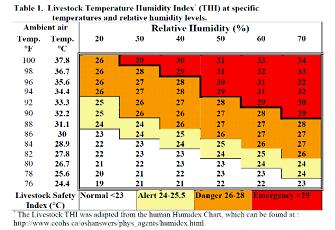| | How Cattle Respond to Heat
Heat stress is defined as any combination of temperature, humidity, radiation and wind producing conditions higher than the animal's thermal neutral zone causing the cattle’s body temperature to begin to rise. High temperatures, above 28°C (82°F), coupled with high humidity can cause heat stress in cattle. Cattle cool themselves primarily through a combination of respiratory tract (panting) and skin evaporative loss (sweating). Cattle are more sensitive to high temperatures than humans, and capable of sweating only 10% of what humans do. Heat stress can compromise weight gain, feed intake, reproductive performance including gestation length, milk production, calf birth weight, male fertility, and in the worst cases may increase the chance of illness and even cause death.
Signs of Heat Stress:
- increased respiratory rate (shallow rapid breathing advancing to open mouth panting to shallow and weak breathing)
- sweating
- drooling
- changing behavior to stand in the shade or water, or face directly into the sun to reduce exposure
- stumble when walking
- huddle to seek shade from others
- reduced appetite
- in extreme cases cattle will collapse, convulse, and slip into a coma with death occurring shortly after
When to be Concerned?
- Early in the summer season before cattle have acclimatized to higher temperatures
- Adaption to a thermal challenge requires 3-4 days after onset of a heat wave
- Over a period of time, consecutive hot days are worse than intermittent hot days.
- When the temperature doesn’t drop enough in the evening
- High humidity such as after a rain storm reducing heat tolerance
- Calm days with little wind, no shade or cloud cover
The greatest probability of cattle heat stress occurs between early July and mid-August when ambient air temperature is greater than 30°C and the relative humidity (RH) is above 30%
Animals at risk:
- Dark-hided cattle vs light-hided cattle
- The most productive animals - those with the highest growth rate and milk production
- Confined animals vs animals on range or pasture
- Animals nearing to slaughter weight- higher body mass to surface area ratio and more fat cover
A free livestock and poultry heat stress app was developed by the University of Guelph and OMAFRA
http://www.omafra.gov.on.ca/english/engineer/facts/heat-app.htm
What can be done to help?
Plan
Inform yourself, be proactive, develop a strategic plan, observe and recognize animals in distress and take appropriate tactical action.
Monitor
The Livestock Temperature Index (Table 1) combines the the effects of temperature and humidity into one value. The Livestock Safety Index can be divided into three stress categories to alert producers of potential heat stress periods for livestock. Observing and noting respiratory rate is an easy and an effective way to assess level of heat stress.
Alert
LSI 24 -25.5: when the index reaches this range, heat stress will first appear. Precautionary measures should be taken to reduce heat stress conditions in confinement housing or livestock trailers.
Danger
LSI of 26-28: an index in this category is dangerous for confined animals.
Emergency
LSI ≥ 29: these conditions are most likely to occur when air temperature exceeds 32°C (90°F). No cloud cover and little air movement are additional hazards. Livestock should not be worked or shipped when the index reaches this level.

Alter
- Environment
- Provide shade without reducing airflow
- Increase ventilation and air flow – reduce wind breakers such as thick crops or tree lines, topography or man-made structures
- Activities
- Avoid handling or performing painful or stressful procedures during times of peak or concerning temperature
- Work feedlot cattle between midnight and 8am
- Spray the animals or shelter roof down with cool water and allow for evaporation
- Feed
- Adjust feeding schedule - feed 2 to 4 hours after the peak ambient temperature of the day
- Feed highly digestible feed to reduce metabolic rate and heat production
- Water
- Increase quantity of cool water provided
- Replenish electrolytes by providing salt licks
- Test the quality of your water source on a regular basis
- Dugout water quality can change over time depending on run-off, snow thaw and heat. Evaporation can lead to high concentrations of salt that can be deadly
- .Do not rely on visual detection – salty water will look clean and clear
INTERVENE
Consult your veterinarian immediately for advice.
For more information:
http://cru.cahe.wsu.edu/CEPublications/FS157E/FS157E.pdf
Print Fact Sheet:
If you have questions or require further assistance on this topic, please call the Ag-Info Center at 310-FARM.
|
|